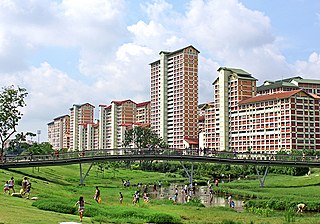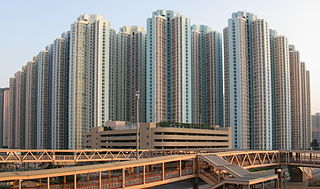
Public housing is a form of housing tenure in which the property is usually owned by a government authority, either central or local. Although the common goal of public housing is to provide affordable housing, the details, terminology, definitions of poverty, and other criteria for allocation vary within different contexts. Within the OECD, social housing represents an average of 7% of national housing stock (2020), ranging from ~34% in the Netherlands to less than 1% in Colombia.

A lease is a contractual arrangement calling for the user to pay the owner for the use of an asset. Property, buildings and vehicles are common assets that are leased. Industrial or business equipment are also leased. Basically a lease agreement is a contract between two parties: the lessor and the lessee. The lessor is the legal owner of the asset, while the lessee obtains the right to use the asset in return for regular rental payments. The lessee also agrees to abide by various conditions regarding their use of the property or equipment. For example, a person leasing a car may agree to the condition that the car will only be used for personal use.

The Home Ownership Scheme (HOS) is a subsidised-sale public housing programme managed by the Hong Kong Housing Authority. It was instituted in the late 1970s as part of the government policy for public housing with two aims – to encourage better-off tenants of rental flats to vacate those flats for re-allocation to families in greater housing need; and also to provide an opportunity for home ownership to families unable to afford to buy in the private sector.
Property management is the operation, control, maintenance, and oversight of real estate and physical property. This can include residential, commercial, and land real estate. Management indicates the need for real estate to be cared for and monitored, with accountability for and attention to its useful life and condition. This is much akin to the role of management in any business.
Subsidized housing is government sponsored economic assistance aimed towards alleviating housing costs and expenses for impoverished people with low to moderate incomes. In the United States, subsidized housing is often called "affordable housing". Forms of subsidies include direct housing subsidies, non-profit housing, public housing, rent supplements/vouchers, and some forms of co-operative and private sector housing. According to some sources, increasing access to housing may contribute to lower poverty rates.

The Hong Kong Housing Society, or Housing Society for short, is the second largest public housing provider in Hong Kong. The Society housed around 130,000 residents as of 2020. The Housing Society has been a dedicated housing provider in constantly identifying the housing needs of different sectors of the community and developing housing options attuned to their needs. Since its inception, a total of over 73,000 units have been built under different housing schemes, including Rental Estate, Rural Public Housing, Urban Improvement Scheme, Flat-for-Sale Scheme, Sandwich Class Housing Scheme, Full Market Value Development, Urban Renewal Project, Senior Citizen Residences Scheme, The Tanner Hill and Subsidised Sale Flats project.

Public housing in Hong Kong is a set of mass housing programmes through which the Government of Hong Kong provides affordable housing for lower-income residents. It is a major component of housing in Hong Kong, with nearly half of the population now residing in some form of public housing. The public housing policy dates to 1954, after a fire in Shek Kip Mei destroyed thousands of shanty homes and prompted the government to begin constructing homes for the poor.
Rent control in Ontario refers to a system of rent regulation in Ontario, Canada which limits the amount by which the rent paid by tenants for rental accommodation can increase. It applies to any unit that was first occupied for residential purposes before November 15, 2018.

Multifamily residential, also known as multidwelling unit (MDU)) is a classification of housing where multiple separate housing units for residential inhabitants are contained within one building or several buildings within one complex. Units can be next to each other (side-by-side units), or stacked on top of each other (top and bottom units). Common forms include apartment building and condominium, where typically the units are owned individually rather than leased from a single building owner. Many intentional communities incorporate multifamily residences, such as in cohousing projects.

Housing in Hong Kong varies by location and income. More than 7 million people live on about 1,108 km2 (427 mi2) of land in the region, making it one of the densest places in the world.
The following shows the public housing estates in Pok Fu Lam, Aberdeen, Wong Chuk Hang and Ap Lei Chau of Southern District, Hong Kong.
The Ellis Act is a 1985 California state law that allows landlords to evict residential tenants to "go out of the rental business" in spite of desires by local governments to compel them to continue providing rental housing.
My Home Purchase Plan is one of the public housing initiatives of Hong Kong. This plan enables eligible citizens to purchase homes by way of "rent-and-buy". The Plan aims to provide assistance to potential sandwich class home buyers who are able to repay mortgages in the long term but currently do not have enough savings for the down payment. This plan is introduced by the Chief Executive of Hong Kong in the Policy address of Hong Kong 2010. The implementation of plan, that is the first 5000 flats under the plan is expected to be ready for sell in 2014.
The history of rent control in England and Wales is a part of English land law concerning the development of rent regulation in England and Wales. Controlling the prices that landlords could make their tenants pay formed the main element of rent regulation, and was in place from 1915 until its abolition by the Housing Act 1988.
A property tax known as "rates" has been levied in Hong Kong since 1845. The tax applies to all domestic and commercial properties unless exempted, and is based upon the rental value of the property, re-assessed each year. Formerly part of the revenue went to the Urban Council and, from 1986, the Regional Council, but since 2000 the whole amount goes to the Hong Kong Government.
A bedspace apartment, also called cage home (籠屋), coffin cubicle, or coffin home(棺材房), is a type of residence that is only large enough for one bunk bed surrounded by a metal cage. This type of residence originated in Hong Kong, and primarily exists in older urban districts such as Sham Shui Po, Mong Kok, To Kwa Wan, and Tai Kok Tsui. In 2007, there were approximately 53,200 people living in cage homes in Hong Kong.
Rent regulation is a system of laws, administered by a court or a public authority, which aims to ensure the affordability of housing and tenancies on the rental market for dwellings. Generally, a system of rent regulation involves:
The Costa–Hawkins Rental Housing Act ("Costa–Hawkins") is a California state law, enacted in 1995, which places limits on municipal rent control ordinances. Costa–Hawkins preempts the field in two major ways. First, it prohibits cities from establishing rent control over certain kinds of residential units, e.g., single-family dwellings and condominiums, and newly constructed apartment units; these are deemed exempt. Second, it prohibits "vacancy control", also called "strict" rent control. The legislation was sponsored by Democratic Senator Jim Costa and Republican Assemblymember Phil Hawkins.

The Housing Act 1988 is an Act of Parliament in the United Kingdom. It governs the law between landlords and tenants. The Act introduced the concepts of assured tenancy and assured shorthold tenancy. It also facilitated the transfer of council housing to not-for-profit housing associations, which was then carried out partly through the system of Large Scale Voluntary Transfer.
The current pet keeping policy in public housing estates in Hong Kong was introduced in 2003 by the Housing Department after the outbreak of Severe Acute Respiratory Syndrome (SARS). Its objective is to improve the hygiene of public housing estates. Under the policy, public housing tenants are allowed to keep small household pets such as cats and birds but are prohibited from keeping dogs at their premises except under special circumstances, subject to the approval granted by the Housing Authority. The policy has led to debates and calls for amendments.







